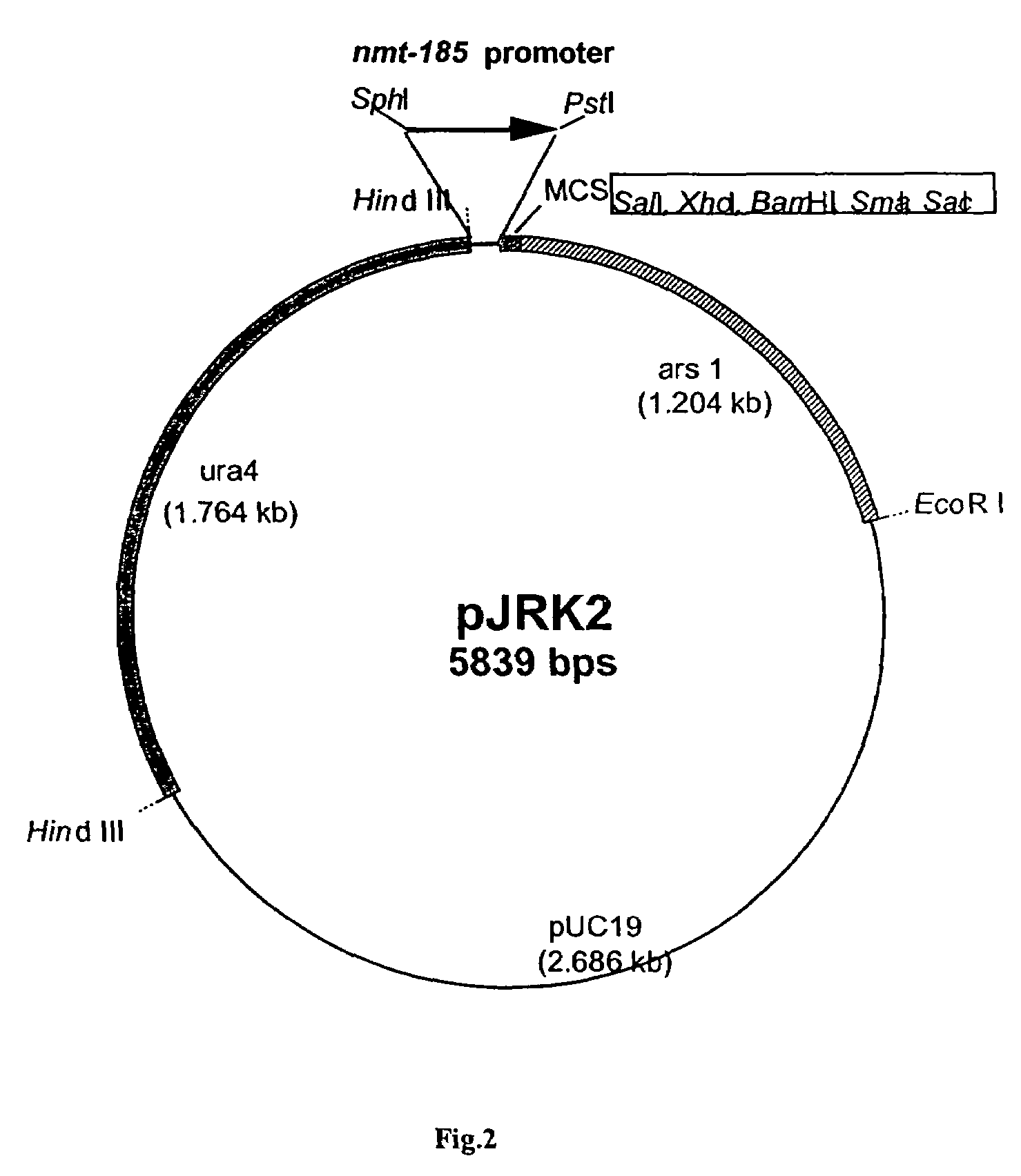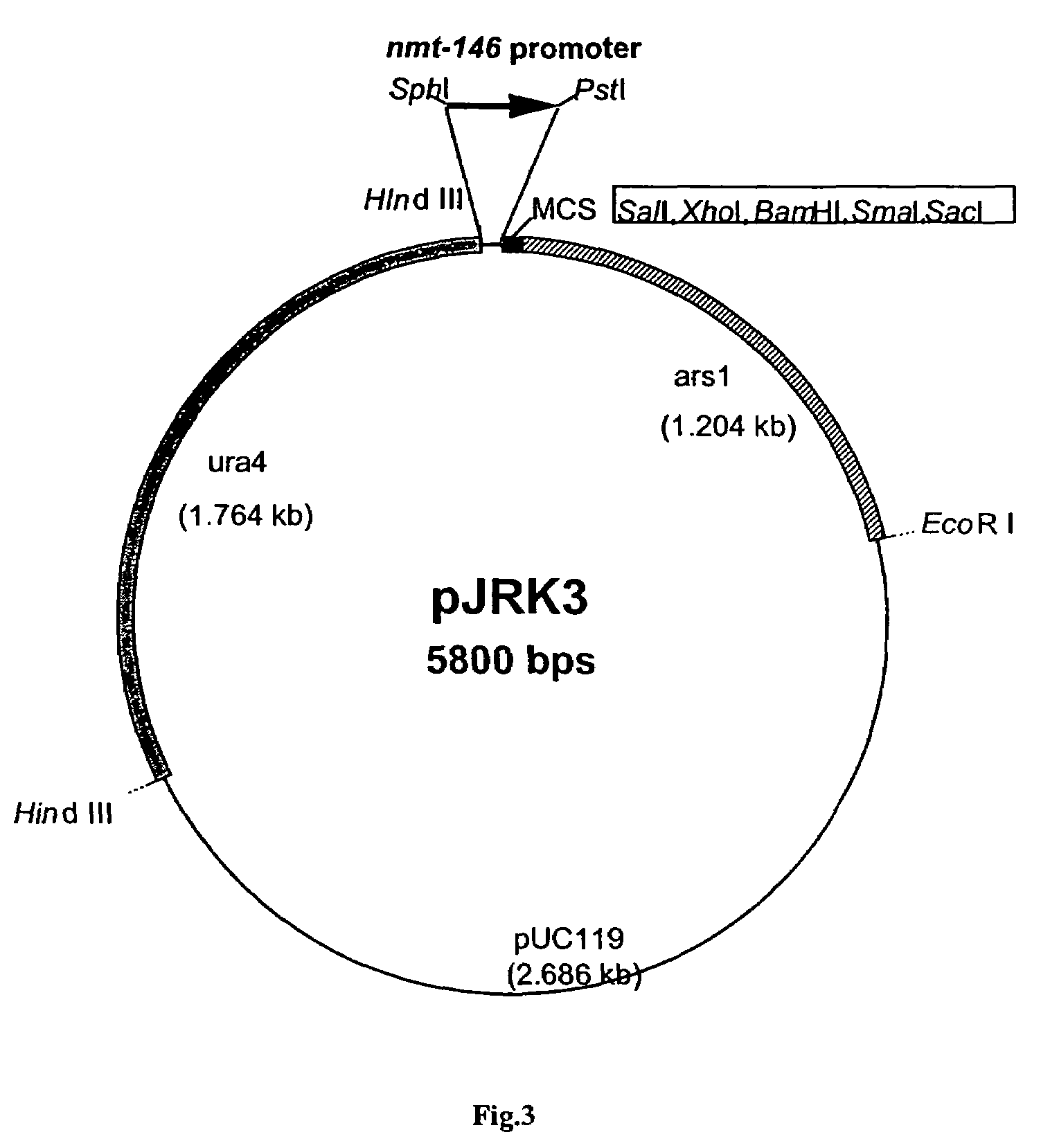Temperature regulated promoters from Schizosaccharomyces pombe for expression of proteins
a technology of schizosaccharomyces pombe and promoter, which is applied in the field of temperature promoters and set of expression vectors, can solve the problems of uninduced transcription, inability to regulate expression using this promoter very tight, and cell expressing the vector does not grow well under the inducing conditions, etc., and achieves the effect of facilitating the induction of expression, and reducing the number of inducible genes
- Summary
- Abstract
- Description
- Claims
- Application Information
AI Technical Summary
Benefits of technology
Problems solved by technology
Method used
Image
Examples
example 1
Isolation of Promoter Elements
[0103]For search of promoters, a genomic library was constructed. For this, genomic DNA was isolated from wild type S. pombe strain having no known auxotrophic markers. Partial digestion of the genomic DNA was carried out with Sau3AI, to obtained maximum amount of DNA in the range of 100 bp to 2000 bp. The Sau3AI digested genomic DNA was ligated to the unique BamHI site in the vector pGFP (without promoter).
[0104]The above S. pombe ‘promoter’ library with GFP reporter was transformed into S. pombe strain. The yeast transformants were replica plated on PMA-leu plates containing different concentration of glucose, galactose, sodium chloride, copper and zinc. The same transformants were also replica plated on to PMA-leu plate in triplicate and incubated at different temperatures. Expression was followed under the different conditions by directly monitoring the green fluorescence of colonies when exposed to UV.
[0105]Two clones were isolated from the above s...
example 2
Expression of GFP by nmt-185 Promoter
[0110]To monitor the expression level induced by the new promoter element, the gene encoding the green fluorescent protein (GFP) was cloned in the MCS of the vector pJRK2 (Accession no. MTCC 5106) (FIG. 3). The same gene was also cloned in front of the nmt1 promoter for comparison of level of expression. Flow cytometry analysis was used to quantify the amount of GFP protein expressed under the control of nmt-185 at different time intervals of induction. As yeast cells have some background autofluorescence when irradiated at 488 nm, the fluorescence profile of S. pombe strain having control vector was analyzed first. S. pombe cells were grown to mid-exponential phase in rich medium under repressed conditions (36° C.) and then shifted to expressed condition in a selective medium (25° C.). Samples were taken at 0, 2, 3, 4, 6, 9, 12, and 15 hours of induction and the fluorescence profile of 10,000 cells analyzed. In case of the nmt-185 promoter, the ...
example 3
Expression of cdc18 Gene of S. pombe by nmt-185 Promoter
[0113]The new promoter element nmt-185 isolated from the promoter screen was also used to monitor the expression of cell division cycle gene cdc18 from S. pombe. Overproduction of cdc18 has been shown to cause delay in mitosis and more than one round of DNA synthesis leading to a drastic elongation of cells. In the present example expression of cdc18+gene was carried out under the control of nmt-185 promoter.
[0114]The cdc18 gene was cloned into the multiple cloning sequence (MCS) of the vector pJRK2 (Accession no. MTCC 5106) and transformed in to a wild type strain of S. pombe. Similarly, the cdc18 gene was also cloned in front of the nmt1 promoter. Cells were grown to exponential phase in medium containing thiamine (promoter off) at 36° C., washed extensively and transferred to fresh media without thiamine at 25° C. (promoter on) to induce the expression of cdc18. Samples were withdrawn after 0, 2, 3, 4, 6, 9, 12, and 15 hours...
PUM
| Property | Measurement | Unit |
|---|---|---|
| temperature | aaaaa | aaaaa |
| time | aaaaa | aaaaa |
| temperature | aaaaa | aaaaa |
Abstract
Description
Claims
Application Information
 Login to View More
Login to View More - R&D
- Intellectual Property
- Life Sciences
- Materials
- Tech Scout
- Unparalleled Data Quality
- Higher Quality Content
- 60% Fewer Hallucinations
Browse by: Latest US Patents, China's latest patents, Technical Efficacy Thesaurus, Application Domain, Technology Topic, Popular Technical Reports.
© 2025 PatSnap. All rights reserved.Legal|Privacy policy|Modern Slavery Act Transparency Statement|Sitemap|About US| Contact US: help@patsnap.com



